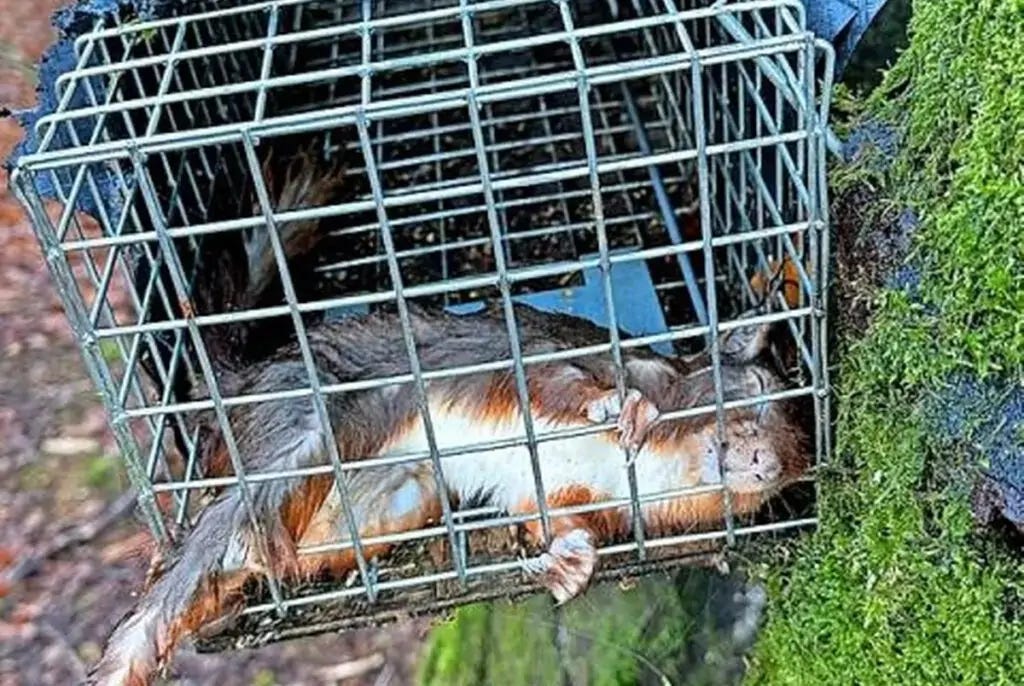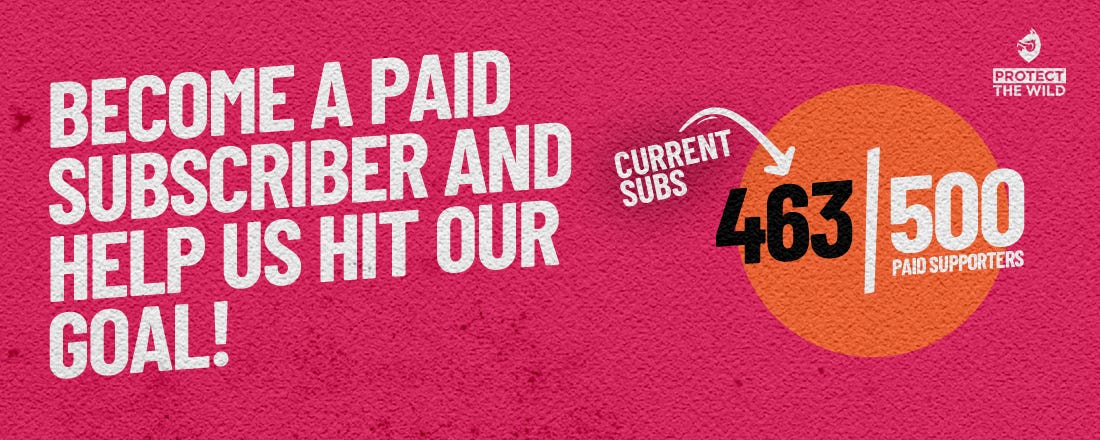Red squirrel suffers slow and painful death in unmonitored trap
Image shows how barbaric supposedly 'humane' animal traps can be
Scotland's Daily Record has published a photo of a trapped red squirrel, who had likely suffered a slow death from starvation and dehydration. The horrific image shows just how barbaric and torturous even supposedly 'humane' animal traps are if they are not regularly checked by the operator.
Dog walker Paula McLachlan discovered the body of the squirrel in woods near the village of Dalton, close to Lockerbie in Dumfries and Galloway, Scotland.
Paula wrote on a wildlife and birding Facebook group:
“Saw this on my walk in the woods just outside of Dalton, on the road to Hightae. I assume whoever set this trap was intending to catch grey squirrels, not red, but why would there be a trap like this, in woodland where red squirrels live, if the trap isn’t constantly monitored? There are few enough left, absolutely horrible to see one dead through being trapped.
When I initially found the squirrel dead on Monday morning, it looked like it had been there at least a day already. I went back on Tuesday and it was still there.”
Paula stated that the squirrel had died while trying to claw her way out of the trap. Protect the Wild's Glen Black said:
"This squirrel trap closes when an animal enters and they can't get out. Sadly the squirrel in that photo probably died of thirst of hunger."
Photo by Rebecca Prest on Unsplash
Illegal trap use
It is thought that the trap was set by a grey squirrel monitor. Grey squirrels are an introduced species in the UK, and have been held responsible for killing off much of our native red squirrel population. Scotland has a grey squirrel-trapping programme, coordinated with Saving Scotland's Red Squirrels (SSRS). The organisation states:
"At this time, halting further spread of grey squirrels in strategically targeted areas is the only viable option to fully protect the strong red squirrel populations we still have across Scotland. Trapping or shooting are the only available means of doing this in Scotland. The SSRS project utilises live cage-trapping according to best practice guidelines, and then dispatches the animal in the most humane way possible."
However, SSRS stated that this unmonitored trap was not one of theirs.
It is, unfortunately, perfectly legal to trap and kill grey squirrels. ShootingUK gives advice to gamekeepers stating that:
"The main advantage of using traps is that they’re constantly active, working even while you aren’t there.
The downside is they need frequent checking in the case of kill traps, while live catch traps need to checked daily with efforts made to not leave grey squirrels in traps overnight. Users need to be aware that the Animal Welfare Act 2006 protects all trapped animals and any action or failure to act could constitute an offence."
So whoever left the squirrel in the trap has broken the law. The police have been informed and said that "enquiries are ongoing". Let's hope that they take this wildlife crime seriously.

The grey squirrel scapegoat
Red squirrel numbers in the UK have now decreased to around 120,000, most of whom live in Scotland. Grey squirrels were introduced from North America by collectors and wealthy landowners in the 1880s, and are seen as vermin by those who scapegoat them for wiping out their red cousin. The usual rhetoric is that greys spread squirrelpox, which they are immune to, but which kill reds.
But as Protect the Wild has previously written, the narrative that the grey squirrel is solely responsible for the decline of the red is misguided, and is over-simplifying the issue:
"Yes, Greys brought disease with them, but Red Squirrels were already declining as the woodlands they preferred – and Reds are quite specific about what they need – were being cut down, fragmented and converted. Deforestation in the 18th century led to local extinctions of Red Squirrels across the Highlands, and tree cover bottomed out at under 5% of Britain’s total land surface in 1919 after the First World War.
Post-war advances in agriculture and urbanisation resulted in the felling of almost 50% (and in some areas of England and Wales even 100%) of the “ancient forests” Red Squirrels inhabited. Even where reforestation has taken place, studies in the early 2000s concluded that the three most commonly planted tree species are not suitable for Reds and that plantations of trees favourable for Red Squirrels had now matured, were being intensively felled, and were being replaced with less favourable but more profitable tree species.
And while we may all love Reds now, that has certainly not always been the case. Just as they were recovering somewhat from enormous habitat loss and being hit by the introduction as ‘curiosities’ of Greys, gamekeepers and foresters, who viewed Red Squirrels in their newly-planted woodlands as pests, were busy killing them in huge numbers. A bounty was offered for squirrel tails and between 1903 and 1946, 102,900 Red Squirrels were recorded as being killed In Scotland alone. The Highland Squirrel Club paid out £1,504 for Red Squirrel tails to members from up to 56 estates right up until 1946 (increasing the bounty from 4d to 6d as squirrels became more scarce). Records don’t include tails not submitted or the estates that did not belong to the group, so the actual figures killed are probably far higher. Right until the end of 1970s – when the majority of England and Wales held no populations numerous enough to be self-sustaining – Red Squirrels were still legally “pests”."
On top of all this, the very predators who might have kept grey squirrel numbers down, such as pine martens, wild cats and raptors, were being murdered by landowners across the UK, many of whom were murdering the red squirrels, too.

As we have seen with the scapegoating of badgers in the fight to combat bovine Tb, it is more convenient to blame an animal who can't speak or fight back than to critically look at the actions of humans.
Protect the Wild continued:
"It’s far easier to scapegoat an ‘alien’ species than ourselves, but there are another three factors that are impacting Red Squirrels today that are definitely human-based: road traffic accidents, predation by cats and dogs, and poor forestry practice...
[Red squirrels] are now fully protected by Schedules 5 and 6 of the Wildlife & Countryside Act and should be safe at all times. They’ve certainly come a long way since the organised killings that so depleted them less than a hundred years ago. Grey Squirrels, conversely, have no protection, and since 2019 and the Invasive Alien Species Order can’t even be released into the wild after rehabbing at a wildlife hospital."
Pine Marten Kits. Shutterstock
Alternatives exist
There are alternative solutions to killing grey squirrels, such as improving habitats where red squirrels will thrive, development of a squirrelpox vaccine, and ensuring the continuing increase in the numbers of native predators like the pine marten.
Protect the Wild thinks it is a travesty that this red squirrel was left to die of starvation or thirst in a trap, and we want to see justice for the poor creature. But we don't want to see grey squirrels suffering the same fate. We believe that it is through no fault of its own that the grey squirrel is labelled 'vermin' or 'tree rat', and that there must be compassionate solutions for both cousins. Our nature-depleted country has changed, along with the animals in it. It is unacceptable to suggest that grey squirrels must be eradicated completely from the UK.
Let's look at the actions of humans and hold ourselves to account. It is down to us whether the red squirrel thrives. We need to stop scapegoating the grey and take responsibility.
For a deeper read on Protect the Wild's opinion on red and grey squirrels, please read our Squirrel Facts page here.
For more information on the legal and illegal use of traps see our Protectors of the Wild pages on Spring Traps and the Law and Cage Traps and the Law
Help us support activists on the ground!
Our content is free but if you choose to take out a paid subscription you’ll be helping activists on the ground take direct action to protect wildlife. Every penny we receive tops up our Equipment Fund to support those in the field. We currently have an amazing 463 of you on paid subscriptions helping fund the above, can you help us reach our goal of 500?







Red or Grey, what a cruel death. I would smash the trap up so it could not be used again. The traps are supposed to be humane. I have ripped out many a snare , traps etc and disposed of them. One had even caught a cat . The evil scum.
So sick of stupid people in this world!!!
Rest in peace little one. P.s find the jerk that set the trap and lock that person up and see how they like it.